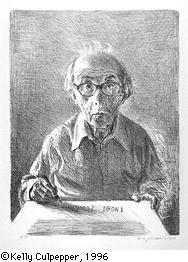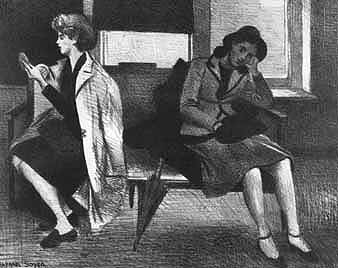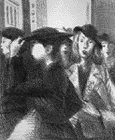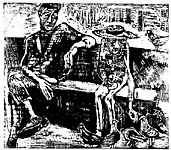 Raphael Soyer was
born on December 25, 1899 in Tombov, Russia. His father was a professor of Hebrew
literature and history in southern Russia, and because of his learned and open minded
nature, the Soyer home became a gathering spot for artists and intellectuals. Because the
Tzarist Russians feared the liberal center the household had become and because the Soyers
were Jewish, the family was deported in 1912. In search of religious and intellectual
freedom, the Soyer family settled in the Lower East side of New York city where Raphael
and his twin brother Moses, depicted the life they saw around them. In the following years
Raphael studied drawing and painting at Cooper Union, the National Academy of Design, and
with Guy Pene Du Bois at the Art Students League. He had his first one-man exhibition in
1929, and in succeeding years won an impressive array of awards. Soyer's major themes are
female nudes, the poor of New York, and portraits of friends and of himself. Raphael Soyer was
born on December 25, 1899 in Tombov, Russia. His father was a professor of Hebrew
literature and history in southern Russia, and because of his learned and open minded
nature, the Soyer home became a gathering spot for artists and intellectuals. Because the
Tzarist Russians feared the liberal center the household had become and because the Soyers
were Jewish, the family was deported in 1912. In search of religious and intellectual
freedom, the Soyer family settled in the Lower East side of New York city where Raphael
and his twin brother Moses, depicted the life they saw around them. In the following years
Raphael studied drawing and painting at Cooper Union, the National Academy of Design, and
with Guy Pene Du Bois at the Art Students League. He had his first one-man exhibition in
1929, and in succeeding years won an impressive array of awards. Soyer's major themes are
female nudes, the poor of New York, and portraits of friends and of himself.
Much of Raphael Soyer's work
concentrated on scenes from the everyday experience of urban living. For inspiration, Soyer turned to
the streets of New York City; for models, he would sometimes hire the homeless. His work
has a sad, sentimental quality that, in the words of one critic, highlighted "a
series of episodes in the lives of simple, even drab human beings." In Working Girls
Going Home, the viewer is drawn to the women's tired faces, which are surprisingly similar
to one another. Soyer shows them close up, but their faces reveal few details, and some
are in shadow. This sense of anonymity and sameness is reinforced by the artist's choice
to place the women's covered heads all at the same height. urban living. For inspiration, Soyer turned to
the streets of New York City; for models, he would sometimes hire the homeless. His work
has a sad, sentimental quality that, in the words of one critic, highlighted "a
series of episodes in the lives of simple, even drab human beings." In Working Girls
Going Home, the viewer is drawn to the women's tired faces, which are surprisingly similar
to one another. Soyer shows them close up, but their faces reveal few details, and some
are in shadow. This sense of anonymity and sameness is reinforced by the artist's choice
to place the women's covered heads all at the same height.
 Although his work has been submerged by interest in
other art movements, he has always enjoyed a small but loyal group of collectors. Soyer
died in 1987. Although his work has been submerged by interest in
other art movements, he has always enjoyed a small but loyal group of collectors. Soyer
died in 1987.
|

 Raphael Soyer was
born on December 25, 1899 in Tombov, Russia. His father was a professor of Hebrew
literature and history in southern Russia, and because of his learned and open minded
nature, the Soyer home became a gathering spot for artists and intellectuals. Because the
Tzarist Russians feared the liberal center the household had become and because the Soyers
were Jewish, the family was deported in 1912. In search of religious and intellectual
freedom, the Soyer family settled in the Lower East side of New York city where Raphael
and his twin brother Moses, depicted the life they saw around them. In the following years
Raphael studied drawing and painting at Cooper Union, the National Academy of Design, and
with Guy Pene Du Bois at the Art Students League. He had his first one-man exhibition in
1929, and in succeeding years won an impressive array of awards. Soyer's major themes are
female nudes, the poor of New York, and portraits of friends and of himself.
Raphael Soyer was
born on December 25, 1899 in Tombov, Russia. His father was a professor of Hebrew
literature and history in southern Russia, and because of his learned and open minded
nature, the Soyer home became a gathering spot for artists and intellectuals. Because the
Tzarist Russians feared the liberal center the household had become and because the Soyers
were Jewish, the family was deported in 1912. In search of religious and intellectual
freedom, the Soyer family settled in the Lower East side of New York city where Raphael
and his twin brother Moses, depicted the life they saw around them. In the following years
Raphael studied drawing and painting at Cooper Union, the National Academy of Design, and
with Guy Pene Du Bois at the Art Students League. He had his first one-man exhibition in
1929, and in succeeding years won an impressive array of awards. Soyer's major themes are
female nudes, the poor of New York, and portraits of friends and of himself.  urban living. For inspiration, Soyer turned to
the streets of New York City; for models, he would sometimes hire the homeless. His work
has a sad, sentimental quality that, in the words of one critic, highlighted "a
series of episodes in the lives of simple, even drab human beings." In Working Girls
Going Home, the viewer is drawn to the women's tired faces, which are surprisingly similar
to one another. Soyer shows them close up, but their faces reveal few details, and some
are in shadow. This sense of anonymity and sameness is reinforced by the artist's choice
to place the women's covered heads all at the same height.
urban living. For inspiration, Soyer turned to
the streets of New York City; for models, he would sometimes hire the homeless. His work
has a sad, sentimental quality that, in the words of one critic, highlighted "a
series of episodes in the lives of simple, even drab human beings." In Working Girls
Going Home, the viewer is drawn to the women's tired faces, which are surprisingly similar
to one another. Soyer shows them close up, but their faces reveal few details, and some
are in shadow. This sense of anonymity and sameness is reinforced by the artist's choice
to place the women's covered heads all at the same height. Although his work has been submerged by interest in
other art movements, he has always enjoyed a small but loyal group of collectors. Soyer
died in 1987.
Although his work has been submerged by interest in
other art movements, he has always enjoyed a small but loyal group of collectors. Soyer
died in 1987.